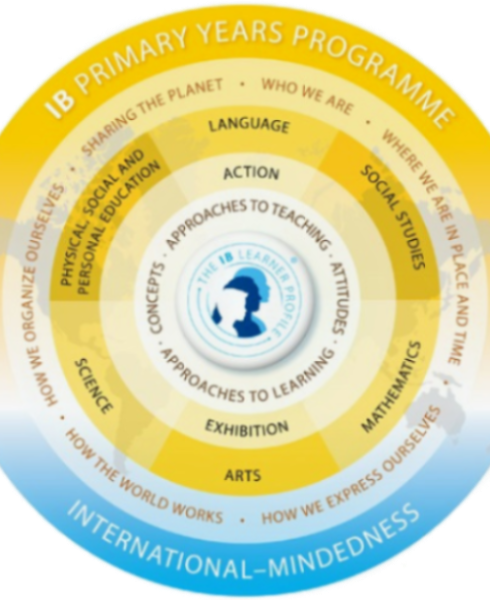
Alexander Charles Morton-Wright
.png)

Designing the Ideal Early Childhood Education Program
Curriculum
The curriculum will be a mash-up of IBPYP with its interdisciplinary themes and student-led project-based learning (PBL) inquiry with HighScope's plan-do-review philosophy. For comprehensive character development of children, the IB learner profile will be used, but with a development, a checklist to clearly assess student progress. HighScope's active participatory learning will be used for small group teaching sessions and their SEL conflict resolution.
There will be opportunities for students to work together on child-initiated activities as well as teacher-initiated activities, and students will be allowed a voice in their choice of activities, how they manipulate materials, and whom they work with. This will let students know that their thoughts and ideas are valued and respected. Students who feel valued and respected are more likely to remain on task and less likely to act up.
Transdisciplinary Themes
Who we are
An inquiry into the nature of the self; beliefs and values; personal, physical, mental, social and spiritual health; human relationships including families, friends, communities, and cultures; rights and responsibilities; what it means to be human.
Where we are in place and time
An inquiry into orientation in place and time; personal histories; homes and journeys; the discoveries, explorations and migrations of humankind; the relationships between and the interconnections of individuals and civilizations, from local and global perspectives.
How we express ourselves
An inquiry into the ways in which we discover and express ideas, feelings, nature, culture, beliefs and values; the ways in which we reflect on, extend and enjoy our creativity; our appreciation of the aesthetic.
How the world works
An inquiry into the natural world and its laws; the interaction between the natural world (physical and biological) and human societies; how humans use their understanding of scientific principles; the impact of scientific and technological advances on society and on the environment.
How we organize ourselves
An inquiry into the interconnections of human-made systems and communities; the structure and function of organizations; societal decision-making; economic activities and their impact on humankind and the environment.
Sharing the planet
An inquiry into rights and responsibilities in the struggle to share finite resources with other people and with other living things; communities and the relationships within and between them; access to equal opportunities; peace and conflict resolution.
Assessment based on Learner Profile
These attributes illustrate the qualities of an internationally-minded person and a lifelong learner. Students will strive to be:
-
Inquirers: Students develop their natural curiosity.
-
Knowledgeable: Students explore concepts, ideas and issues that have both a local and global significance.
-
Thinkers: Students think critically to engage themselves in figuring out complex problems.
-
Communicators: Students express themselves and information through a variety of modes of communication.
-
Principled: Students act honestly and with a strong sense of fairness, justice, and respect for the dignity of the individual, groups, and communities.
-
Open-minded: Students appreciate their own cultures and personal histories and are open to the perspectives, values and traditions of other individuals and communities.
-
Caring: Students show respect and compassion towards the needs of others.
-
Risk-takers: Students approach unfamiliar situations with courage, as well as defend their beliefs.
-
Balanced: Students understand the importance of intellectual, physical and emotional balance to achieve personal well-being.
-
Reflective: Students give thoughtful consideration to their own learning and experience.

IBPYP Approach
The IB learner profile describes a broad range of human capacities and responsibilities that go beyond academic success and imply a commitment to help all members of the school community learn to respect themselves, others and the world around them.
The IBPYP transdisciplinary themes include; who we are, where we are in place and time, how we express ourselves, how the world works, how we organize ourselves, and sharing the planet.
Inquiry-based and student-centered education with responsible action at its core, enabling students to learn between, across and beyond traditional subject boundaries. The framework serves as the curriculum organizer and offers an in-depth guide to achieve authentic conceptual inquiry-based learning that is engaging, significant, challenging and relevant.
High Scope Approach
Plan-Do-Review: Children make choices about what they will do, carry out their ideas, and reflect on their activities with adults and peers. By participating in the plan‐do‐review process, children gain confidence as thinkers, problem‐solvers, and decision-makers. Learning how to act with intention and reflect on the consequences of their actions. Abilities that will serve them well in school and throughout their lives.
Active Participatory Learning: needs five ingredients to be successful. Materials, manipulation, choice, child language and thought, and adult scaffolding.
Conflict Resolution: HighScope uses conflict as a teachable SEL moment and has a six-step process to scaffold children’s understanding of conflict resolution.


Reggio Emelia Approach
Reggio classrooms aim to integrate with the surrounding environment including the rest of the school and its community. Believing children can best create meaning and make sense of their world through environments that support sustained, complex, changing, and varied relationships between people and a world of experiences, ideas and the many ways of expressing these ideas.
Physical Environment: Reggio preschools integrate nature into the classroom with a strong focus on natural light and plants. Classrooms open out into a centre piazza (public square) with open community play areas and access to courtyards with views of the surrounding community. Large windows in classrooms and on walls are used to increase natural light and exterior doors in each classroom to seamlessly switch to outdoor play.